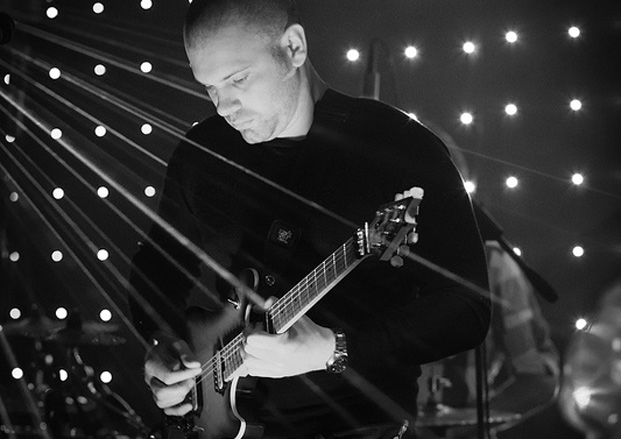How to Build a Pro Multi-Genre Guitar Rig

As guitarists, most of us spend a long time developing our voice on the instrument.
The look and sound we present on stage is a part of our musical identity, and it's honed over a period of years.
One of the biggest challenges for the multi-genre musician can be in building a rig that maintains the player's personal stamp, yet can sound convincing in any style. We want to connect with the audience on an emotional level in any context, yet never dilute our own connection between fingers, guitar and speaker.
So, how do we avoid the hype and build a personalized rig that covers all the bases and—more importantly—makes us want to play?
Route 1: "Pedals and Combo"
There are so many advantages to working this way, not the least of which is that very little is required of the amp other than to function as as a clean, loud, reliable platform for the pedals of your choice. Simply choose your brand and wattage/breakup characteristics—Fender Deluxe, Fender Twin, one of the delectable Dr. Z amps, a Mesa/Boogie Lonestar, or maybe an inexpensive yet effective Peavey Classic. Some of these amps have a great distortion channel as well, which you might stack with pedals of your choice. Although I've nominally called this the "pedal and combo" section, you can get all the same results with a medium-sized head and cab, which may prove to be more portable. You then have the choice of open, closed, or a hybrid cab to tune the feel and response under the fingers vs. projection in the room.
Because you are placing all your favorite drive pedals in front of a clean amp, you don't even particularly need an effects loop (unless you're bringing the amp's drive channel into play). Simply place your compressor and wah pedals first, your drive pedals next, and your time-based effects (chorus, delay, reverb) last in the chain before the amp's input.
Get The Pick Newsletter
All the latest guitar news, interviews, lessons, reviews, deals and more, direct to your inbox!
With vintage fuzz or modulation effects you can experiment with placement for the most authentic response. If you are running several pedals you might notice a little "tone suck", but these days there are solutions to this problem ranging from a simple audio buffer to a full-blown programmable pedal switcher. Even one-box solutions like TC Electronic's Nova System are now combining analogue distortions with rack-quality delays and reverbs; so you can look into replacing some of your pedals with something of this nature; maybe supplementing it with a few choice drives or a tasty germanium fuzz!
The final advantage of this setup often tends to be overlooked. As a pedal user, your main source of distortion and tonal character resides on the floor; if you get bored of one pedal you can simply swap it out for another, or even keep three or four in rotation. Stack a clean boost in front of a mild overdrive, try a mid-boost like the ubiquitous Ibanez Tube Screamer into a high gain pedal—even change the order of these components and you find a whole new set of sounds without spending the Earth. Additionally, certain pedals are now so amp-like in feel and tone that the case for buying their amplifier equivalent can sometimes be difficult to see!
The only real disadvantage with a relatively complex pedalboard is that it can be fiddly and maintenance-intensive. It's well worth researching various cable types, power supply solutions and fixing techniques; building the perfect board is part of the fun, and reliability is paramount in a gig situation. Simply keeping things as neat, tidy and clean as possible can go a long way to avoiding pre-gig headaches. Always carry spares and always have a backup plan in case a pedal or power supply fails!
Route 2: The Channel Switcher
This can be the most maddening and simultaneously the most rewarding route to great tone. Ever since the advent of the Mesa/Boogie Mark II in 1978, manufacturers have been packaging together a clean sound and one or more distortion sounds. Channel switching in the 1980s was somewhat primitive and often compromised, but by the time of the Mesa/Boogie Mark IV, Bogner Ecstasy 100 and Marshall Anniversary in the early 1990s, guitarists genuinely had a selection of all-singing, all dancing workstations available to them.
By the introduction of Bogner's Ecstasy 101 in the mid 1990s, it was beyond any reasonable doubt that from this point on we could have our cake and eat it too. Here was an amp with a Fender clean channel; two stunning, harmonically rich and almost infinitely sculptable drive channels; a great effects loop and more voicing switches than most guitarists would ever use. If the Bogner was too dark and woody, there was Custom Audio Amplification with their OD100 designs. In 1997 Soldano responded with their three channel Decatone and Marshall released the JCM 2000 amps; found everywhere from rehearsal studios to hired backline to Gary Moore or Jeff Beck's stage rigs.
In the 2000s and 2010s the market has been inundated with incredible channel switching amps of all wattages, from Marshall's MIDI-controlled four channel JVM, to ENGL's flexible Powerballs, to MESA/Boogie's Mark V, to the likes of the four channel Diezel VH4 and KSR Colossus at the very top of the boutique market. Simultaneously, a wonderful craze has sprung up for hot-rodded Marshall-style amps with modern features. The more vintage minded channel-switching devotee can choose from the now industry standard Friedman BE-100 (found in the backline of Bon Jovi and many more), Bogner's Helios, Wizard, Landry, Splawn - the list goes on and on until you wonder how guitarists ever get around to actually playing any more!
This is, of course, the pitfall. The quest for the ultimate channel switching amp can be a very time-consuming process. Several times a year something will appear which claims to have a more Fendery clean channel, or tighter lows, or a more woody gain structure, or any number of other distractions. It's important to remember that the amp is a tool that allows you to give voice to your sounds - rather than a box in which to find them. Try to change your amp when it no longer brings the best out of your playing or perhaps if you find it lacks performance as your tastes change. Consider tube-rolling or adding flexibility with a clean boost or drive pedal out front before trading sideways!
A truly great multi-channel amplifier should bring years of enjoyment as your tastes evolve. A good solution that many players have arrived at is to keep two or three top-notch amps in rotation, and change them one at a time if they feel the need. This involves having a lot of money invested in equipment at any one time but can also be very rewarding. It's important to remember at this point that a single professional saxophone or violin can very easily cost £7000-£8000. We guitarists have it good - just don't forget those spare tubes!
Route 3: The Digital Realm
Wouldn't it be amazing if there was a single box that combined all the richness and power of a room full of amps, a selection of characterful vintage and modern pedals, and stacks of rack effects? Something you could simply plug your guitar into and run straight to the mixing desk? Something with no batteries, patch cables or tubes to fail? Well, unless you've been locked in your basement with nothing but a Valvestate 8080 since the late nineties, you'll know that there is! The Line 6 POD was a huge hit, and even the first version can still sound very convincing to our privileged modern ears. Of course, the Line 6 range now faces stiff competition from Fractal's Axe-FX and Kemper's Profiler; the latter of which can even capture and store real amp profiles. The digital effects in the Axe-FX are so good that players like John Petrucci have been employing them purely as a replacement for their now-vintage rack effects units.
The digital amp models have been convincing enough, too, for many top-level guitarists to leave their hot, dusty, glowing tube amps at home. Arguably the feel is the area which still needs the most improvement (even Axe's Cliff Chase has gone on record saying the power section still needs the most work) but these units are getting closer all the time. The allure of having a room full of expensive and potentially unreliable amps stored in a single box is hard to deny, and some of the deep-editing parameters are astounding.
As a one-box solution for the modern studio or gigging guitarist, it's very difficult to make a case against these digital units. One argument is that they do still require on-stage monitoring, so you may still find yourself carrying a full-range monitor of your choice, or running them into a traditional guitar cab (with the unit's speaker modeling disengaged of course). Unless you have a very good relationship with every sound engineer you work with, the need for consistent on-stage monitoring can negate the portability benefits of a digital device.
For many touring bands though, the use of the Axe-FX along with in-ear monitors has given great freedom, consistency, and of course no on-stage bleed. For every lifelong Axe or Kemper devotee though, there is a player who found two or three great digital amp models they liked and returned to the analogue world to buy those amps for real. As always; test, listen, and keep an open mind. The right solution for 99% of the interwebz could be the wrong decision for you!
By Don Stick on Behalf of Bands for Hire.
"Upgrading from your entry-level acoustic opens the door to an entirely new world of tonewoods, body shapes, and brands": 6 signs it's time to upgrade from your first acoustic guitar
"I'm past my prime": 5 common excuses for not learning the guitar – and 5 body and mind-boosting reasons you should







![[from left] George Harrison with his Gretsch Country Gentleman, Norman Harris of Norman's Rare Guitars holds a gold-top Les Paul, John Fogerty with his legendary 1969 Rickenbacker](https://cdn.mos.cms.futurecdn.net/TuH3nuhn9etqjdn5sy4ntW.jpg)


